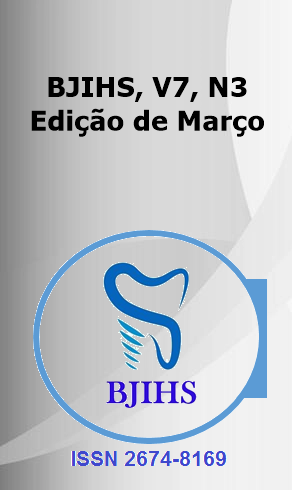Abstract
Introduction: Among the main viral infectious diseases that have become more frequent in Amazonas, the most prominent are dengue, zika, chikungunya and also urban yellow fever, caused by the Aedes Aegypti mosquito. All these pathologies present very similar symptoms, such as intense headache and myalgia, high fever and nausea. Objective: To describe a retrospective five-year period of the occurrence of cases of arboviruses of urban occurrence (dengue, zika virus, chikungunya and yellow fever) in Amazonas. Methodology: This is a retrospective, descriptive study with a quantitative approach using existing public data from Sinan/Net for the years 2019 to 2023. Result: In the five-year period (2019 to 2023), 65,580 cases of urban arbovirus infections (dengue, Zika, Chikungunya) were recorded in the state of Amazonas, with 2023 being the period with the highest number of records of these pathologies (19,396 cases = 29.5%). Severe dengue, which required hospitalization, was the most common infection (65.7% of cases), followed by Chikungunya infection (2.5%) and Zika virus (1.8%). Yellow fever, even though it is considered a rare event, there were 8 records of cases (0.01%) in the period. Conclusion: Prevention is the best way to fight the disease. The best way to prevent dengue fever is to prevent the proliferation of the Aedes Aegypti mosquito, eliminating stored water that can become possible breeding grounds
References
PORTILHO, MM; LIMA, N V S C; CAIRES, P S M. Alterações hematológicas na dengue grave – uma revisão sistemática. RBAC. 2022;54(1):62-67. https://www.rbac.org.br/wp-content/uploads/2022/09/RBAC-vol-54-1-2022_artigo09.pdf
EPIDEMIOLOGICAL UPDATE: Dengue andotherArboviruses - 10 June 2020 (em inglês e espanhol) - OPAS/OMS | Organização Pan-Americana da Saúde [Internet]. Disponível em: https:// www.paho.org/pt/documents/epidemiological-update-dengue-andother-arboviruses-10-june-2020
LUZ, KG et al. Comparação da gravidade dos casos de dengue segundo a classificação. Rev Med (São Paulo). 2018 nov.-dez.;97(6):547-53. https://www.revistas.usp.br/revistadc/article/view/142039/151304
DE MELO, OGDA; MORAES, R BA. Perfil epidemiológico dos casos de dengue notificados em Ceres-Goiás, de 2014 a 2015 Revista de Epidemiologia e Controle de Infecção, vol. 9, núm. 2, 2019, -Junho, pp. 161-166 Universidade de Santa Cruz do Sul Brasil. https://www.redalyc.org/journal/5704/570464096011/570464096011.pdf
SOUSA, JF et al. Perfil epidemiológico da Dengue no estado do Piauí. Brazilian Journal of Health Review, Curitiba, v. 6, n.3, p.13403-13415,may./jun., 2023. https://ojs.brazilianjournals.com.br/ojs/index.php/BJHR/article/view/60897/43972
MINISTÉRIO DA SAÚDE. SECRETARIA DE VIGILÂNCIA EM SAÚDE E AMBIENTE. Boletim Epidemiológico 13. Monitoramento das arboviroses urbanas: semanas epidemiológicas 1 a 35 de 2023. Volume 54 | 22 nov. 2023. https://www.gov.br/saude
EICKMANN, S H et al. Síndrome de la infección congénita del virus Zika. Cad. Saúde Pública 32 (7) 21 Jul 2016. https://www.scielosp.org/article/csp/2016.v32n7/e00047716/
MIRANDA-FILHO DB, MARTELLI CMT, XIMENES RAA, ARAÚJO TVB, ROCHA MAW, RAMOS RCF, et al. Initial description of the presumed congenital Zika syndrome. Am J Public Health 2016; 4:598-600
World Health Organization. Assessment of infants with microcephaly in the context of Zika virus. Interim guidance. Geneva: World Health Organization; 2016. (WHO/ZIKV/MOC/16.3).
PEREIRA, JR; GABAGLIA, CR; DAMASCENO, L; WAKIMOTO, M; RIBEIRO, NRM. Zika vírus infection in pregnant women in Rio de Janeiro - preliminary report. N Engl J Med 2016. http://www.nejm.org/doi/pdf/10.1056/NEJMoa1602412
CALVET, G; AGUIAR, RS; MELO, AS; SAMPAIO, AS; DE FILIPPIS, I; FABRI, A. Detection and sequencing of Zika virus from amniotic fluid of fetuses with microcephaly in Brazil: a case study. Lancet Inf Dis 2016; 16:653-60.
TEIXEIRA, GA et al. Análise do conceito síndrome congênita pelo Zika vírus. Ciência & Saúde Coletiva, 25(2):567-574, 2020. https://www.scielosp.org/pdf/csc/2020.v25n2/567-574/pt
BRASIL. Ministério da Saúde. Monitoramento dos casos de arboviroses até a semana epidemiológica 52 de 2022. Volume 54 | Jan. 2023. https://www.gov.br/saude
KOHLER, LIA et al. Perfil epidemiológico dos pacientes com evolução subaguda e crônica de infecção por Chikungunya. Rev Soc Bras Clin Med. 2018 jan-mar;16(1):13-7. file:///C:/Users/33822280259/Downloads/318-Texto%20do%20artigo-580-1-10-20180524.pdf
BRASIL. Ministério da Saúde. Secretaria de Vigilância em Saúde. Chikungunya: manejo clínico [Internet]. Brasília: MS; 2017.Disponível em: http://portalarquivos.saude.gov.br/
CASTRO, AP; LIMA, RA; NASCIMENTO, JS. Chikungunya: vision of the pain clinician. Rev Dor. São Paulo, 2016 out-dez;17(4):299-302. https://www.scielo.br/j/rdor
DA SILVA, CP et al. Um estudo bibliográfico acerca dos surtos de Febre Amarela no Brasil. Revista Brasileira de Meio Ambiente, v.2, n.1. 027-041 (2018). file:///C:/Users/33822280259/Downloads/58-557-1-PB.pdf
CAVALCANTE, KRLJ et al. Características epidemiológicas da febre amarela no Brasil, 2000-2012. Epidemiol. Serv. Saúde, Brasília, v. 25, p. 11-20, 2016. Disponível em: < http://www.scielo.br/pdf/ress/v25n1/2237-9622-ress-25-01-00011.pdf
PAIXÃO, FAW et al. Casos de dengue no Amazonas nos anos de 2018 a 2022. Research, Society and Development, v. 11, n.9, e30111932053, 2022. https://rsdjournal.org/index.php/rsd/article/view/32053/26915
De Almeida, R. B. & Aleixo, N. C. R. (2022). Análise socioambiental da morbidade da malária em Manaus, Amazonas, Brasil. Revista Brasileira de Climatologia,(30), 845-866
De Barros Moreira, L. S. et al. (2022). Perfil clínico e epidemiológico da dengue no estado de Minas Gerais. Clinical and epidemiological profile of dengue in the state of Minas Gerais. Brazilian Journal of Health Review, 5(1), 373-387
DOS SANTOS, L R et al. Perfil epidemiológico de gestantes infectadas pelo Zika vírus no Amazonas entre 2016 e 2023. Revista Contemporânea, v. 3, n. 12, 2023. ISSN 2447-0961. https://ojs.revistacontemporanea.com/ojs/index.php/home/article/view/2476/1714
FERNANDES, WR et al. Estratégias para prevenção da dengue, Zika e Chikungunya desenvolvidas na região norte do brasil: o programa saúde na escola em foco. Educação em Debate, Fortaleza, ano 42, nº 83 - set./dez. 2020. https://repositorio.ufc.br/bitstream/riufc/58231/1/2020_art_wrfernandesmfsousa.pdf

This work is licensed under a Creative Commons Attribution 4.0 International License.
Copyright (c) 2025 MARIA JAINE DOS SANTOS, JANDER YAGO DE PAULA CARVALHO, ANN CAROLINE NASCIMENTO CRUZ

